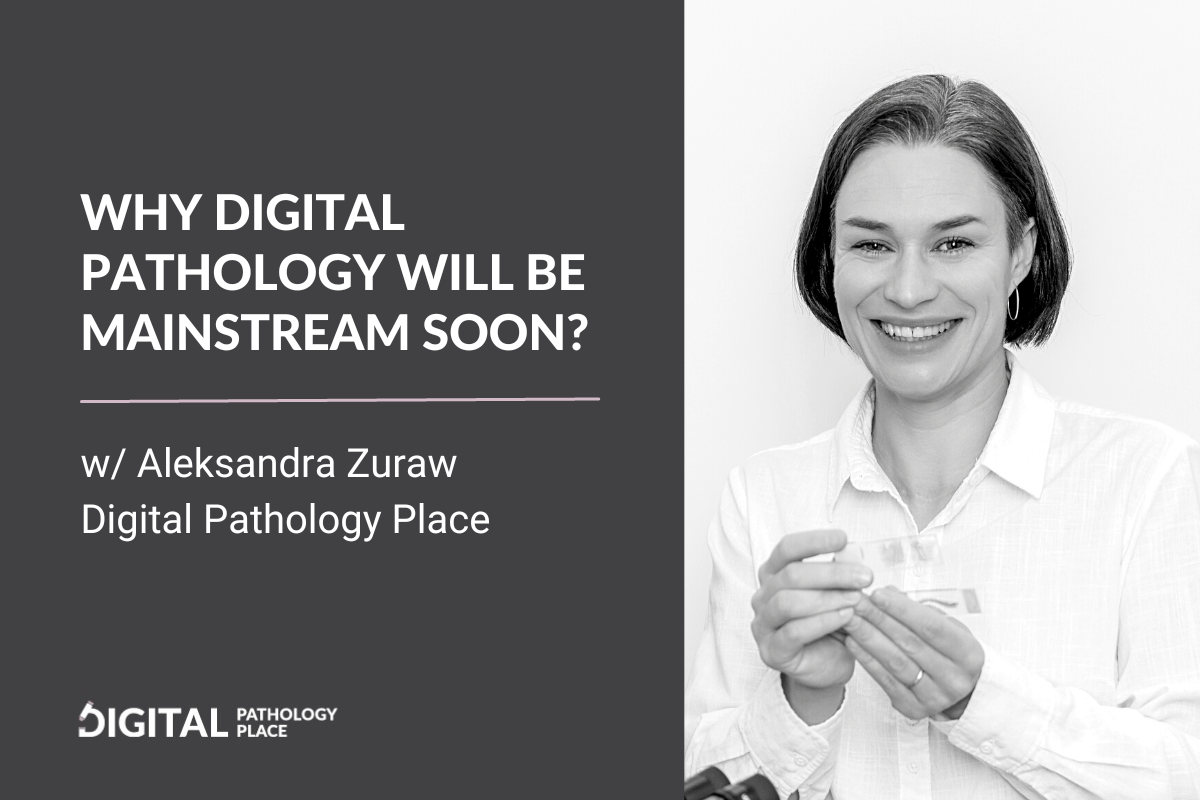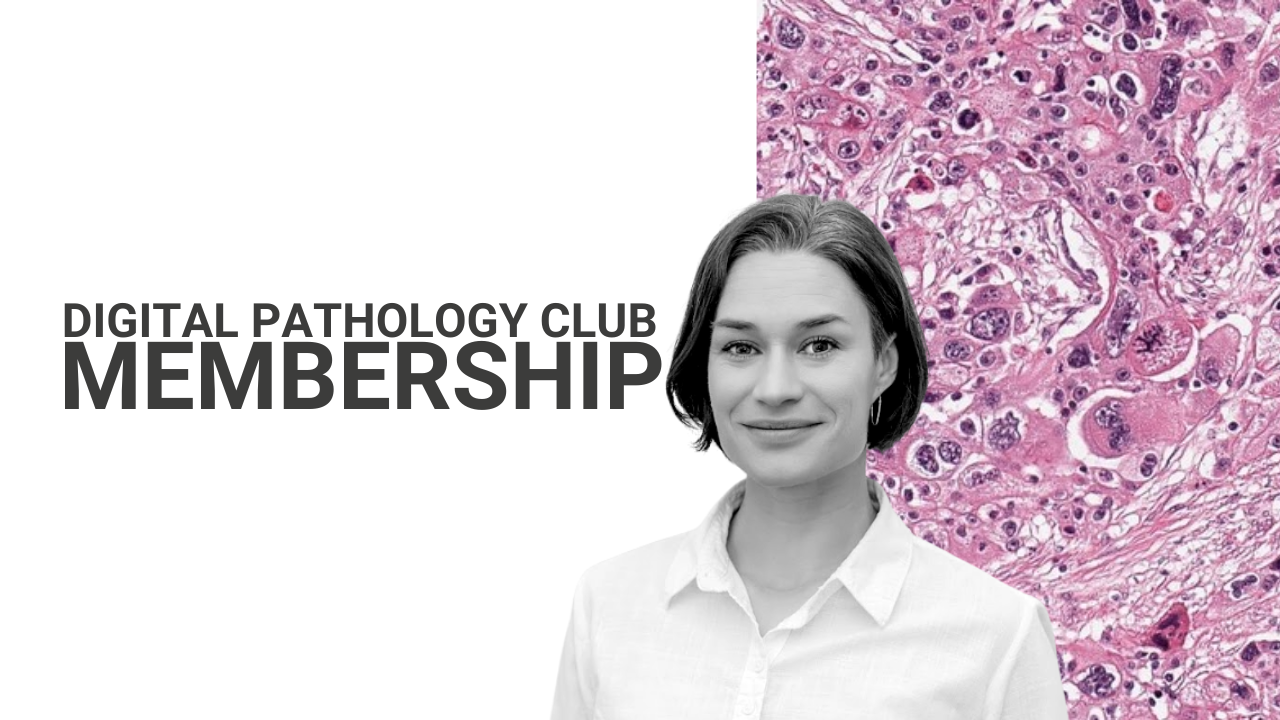Aleksandra: [00:00:26] Welcome my digital pathology trailblazers. I am experimenting with a little bit of a shorter form of a podcast that I would love to deliver to you more often, so let’s start with this little episode today and see where it takes us.
I was posting on LinkedIn. And maybe some of you will have already seen this post and if not, let’s connect on LinkedIn because I love to have a discussion there.
But it’s the end of the year so I was reflecting on how I started with digital pathology and I basically started because it was super cool. And my colleague, I was finishing my PhD, I have just submitted my dissertation, I was done with my residency and it was time to find a job.
And a colleague showed me an ad in the veterinary pathology journal that there was this digital pathology slash tissue image analysis job for a pathologist and I was like, oh, that’s cool. And that’s how I started because I thought it was cool and I was the first full time pathologist supporting the tissue [00:01:26] image analysis team. So even though I was straight out of residency, I became the number one go-to pathology expert because I was the only one and that felt great.
And it was also cool to work with digital images and instead of with microscopic images, even though I was still studying for my boards with the microscope, but this microscope was basically just there for me to study for boards.
All my job was done on digital images and yes, those images would take like 30 seconds, that was fast too, up to even sometimes too over a minute to open, to do a little annotation task that would take you 10 seconds.
Then we were shipping all those images between companies, between our clients and us on hard drives there was a lot of manual QC manual work with those images involved. This annotation tool that I was using, it was crashing every other image I was furious working with this but it was still [00:02:26] super cool.
And I liked this I liked the environment, I liked working with computer scientists, image analysis, scientists in a multidisciplinary environment, being part of software development that was really cool.
But it was definitely not ready for prime time for every pathologist to use it. And now fast forward, six years, end of 2022 all my work is done on digital images, all the studies I evaluate are on digital images, the speed of work, the speed of opening those images and evaluating them and basically working with them matches the speed of the microscope, I’m not slower than I was with the microscope.
And one can argue that I don’t know people with a lot more experience than me would be a lot faster with the microscope, I’m not. To me the speed matches the computer, didn’t crash a single time on me, it doesn’t mean that it never crushes, but the computers crash for [00:03:26] all kinds of different reasons. So that’s not really digital pathology specific and today it was my lucky day it didn’t crush.
I can consult with my colleagues whenever I want, I can basically make screenshots of the images I’m making, I can put pins, do annotations. A lot more efficient workflow for a toxicology pathologist where you have to compare different slides, sometimes several slides at the time, the whole group that lends itself very much to digital pathology.
To a digital pathology workflow, I do not have any slides on my desk, I do not have to receive any huge packages, go pick up those slides and bring them back, they are being uploaded to the cloud, I download them from the cloud overnight, so I can prepare for the next day full of work. They download overnight I don’t have any problems with bandwidth or anything like that I just have a residential [00:04:26] internet.
And I realized that I am part of a minority of privileged pathologists who can do their job that way and I know that, it’s definitely a minority.
But this reminds me off the times when smartphones were just entering the market and not only were they just entering the market, they also didn’t have so many cool features. So I remember seeing the smartphones and seeing people having smartphones and I was dreaming… At the time I was doing my PhD in Berlin and I would drive a lot between Poland and Berlin that was close to the border. And I was dreaming of having a smartphone that would always have access to internet and Google maps. So that I could always find the best way home, the one with least traffic, this was my dream . That was around 2011, 2012.
And I think within a year or a [00:05:26] year and a half at that time, I couldn’t afford the smartphone and that was really like science fiction. I knew it was going that direction, but I didn’t think that within a year I will have this smartphone that I will be able to drive home with, and it would show me the way.
So, yeah. At the beginning, smartphones was like an elite device for the minority. And now would you want to have a different phone? Would you want to replace your iPhone, your smartphone, with the old type of phone? I know some of you would, I know people who still have flip phones but now they are in minority.
So this is what I think is going to happen to digital pathology, how fast it’s going to happen I don’t know, I’m just super happy very selfishly happy, that this already happened to me. That I can guide people who are starting on this journey, and I wouldn’t want to have it any other way anymore, I don’t want to have to try to compare two glass slides under the microscope where I [00:06:26] look at one slide and then I look at the other one I cannot really look at both of them under the microscope. And then within one second, I already forget what I saw in the first one, so like, I don’t compare them.
I’m working entirely remotely, and I would not want to have that any other way, because if I had to drive to work or spend time in the office, I would miss time with my kids. Yesterday, my two year old had a Rudolph the Red-Nosed reindeer recital, and I was able to be there, I pick him up and then whatever I needed to do after they went to sleep, I did.
I was able to be there, I also go to Poland for several weeks at the time. And I want to do this every year, and digital pathology gives me this possibility so for very selfish reasons, I don’t want to do it any other way.
And I know that there are a lot of hurdles. Sometimes it’s clunky, it’s not always seamless but I think it’s going to be like with the [00:07:26] smartphones. And hopefully it’s going to take over pathology as fast as smartphones took over the world. So, yeah, here are a couple of my thoughts for the end of the year. And I wish you a great preparation time for New Years
And if any of you my trailblazers are not yet part of our newsletter. I’m going to leave a link in the description of this episode so that you can join the digital pathology trailblazer community and be notified every time there’s something cool about digital pathology that I want to share with you.
Talk to you in the next episode.












